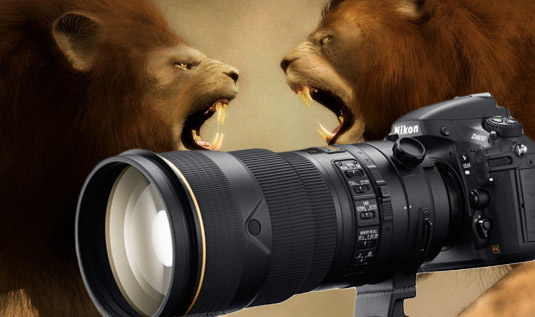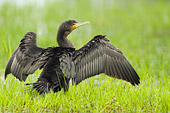The high resolution image has always been associated with large format cameras. Until recently only studio/landscape photographers had the privilege to handle such equipment, not only because of the price but mainly due to the characteristics of the camera itself. They are simply not intended for shooting action/reportage/wildlife photography. With the announcement of Nikon D800 and Nikon D800E, all this suddenly changed. These two cameras turned out to be suitable not only for shooting in a controlled environment and conditions, but also for shooting reportage and wildlife.
Last month I was shooting with Nikon D800E and Nikon AF-S 300mm f/2.8G IF-ED VR lens, which friends were so kind to lend me. The results only confirmed my opinion, which I was left with six months ago when I tested Nikon D800 and Nikon 200-400 f/4G AF-S VR. Each photo is a guarantee for a pixel perfect picture, dynamics and detail. Nikon D800E has a factory removed AA (anti-aliasing) filter, thus it provides a much better detail compared to his brother Nikon D800. This means that even images shot at higher ISO values will have more details and visibly less noise (but not physically) as compared to photos shot with Nikon D800 in the same conditions.
I noticed that the image detail don’t suffer significantly even with a converter. That means bright and high quality prime lenses can utilize easily the resolution of the camera even with a mounted teleconverter. And while most people (who had never used this body) think that the resolution of Nikon D800/D800E is over-pumped, I believe that next year high grade Nikon cameras will be announced and they will push the MP level even further. And this is what Nikon D4x should be – a 45 MP monster in the professional class.
Nikon D800E opens new opportunities for bird/wildlife photographers. The high resolution image means also better quality pictures printed in a size over 60 x 84 cm, but more importantly – even when cropping of the frame is needed, the remaining resolution should be still enough for large size prints without impairing the quality or the detail. Even if you have to crop the file at 40%, there will be still 20 MP tha have remained from the image, which is enough for high resolution prints.
I’ve noticed that prime lenses act differently when they are used with D800E and another full frame camera such as D700 for example. When you put Nikon 300/2.8 on D800E, the lens reaches 95% of its sharpness on f/3.2, whereas from f/3.5 on, the results are the same (except for the DOF of course). With Nikon D700 body, there is ongoing improvement in the quality up to f/5.6, which I think is largely due to “thick” AA filter in the D700.
I will now share with you some files, which I shot entirely with Nikon D800E and Nikon 300/2.8 VR lens. Most of them were shot in adverse conditions – dark humid winter weather, or during handheld shooting at lower speed (than the desired) and high ISO values. The images have been taken from a series of files, they were not selected as per their quality. My only criteria is to pick photos with no motion blur.
Here are the parameters: JPEG at maximum quality file processed from the NEF file with the following settings: Standard, Sharpness 6, Saturation +1, and White Balance according to the situation. The rest parameters are default settings. The displayed images are full frames. Below each one, there is a link to the same image cropped at 100%. If you have questions, don’t hesitate to ask below.

Nikon D800E + Nikon AF-S 300mm f/2.8G IF-ED VR
ISO 1100, f/3.2, 1/500 sec, 100% crop

Nikon D800E + Nikon AF-S 300mm f/2.8G IF-ED VR
ISO 640, f/3.2, 1/800 sec, 100% crop

Nikon D800E + Nikon AF-S 300mm f/2.8G IF-ED VR
ISO 900, f/3.2, 1/800 sec, 100% crop

Nikon D800E + Nikon AF-S 300mm f/2.8G IF-ED VR
ISO 450, f/3.5, 1/1000 sec, 100% crop

Nikon D800E + Nikon AF-S 300mm f/2.8G IF-ED VR + Nikon AF-S TC-17E II Teleconverter (whide-open aperture, the focus is on the feathers bellow the head)
ISO 3200, f/4.8, 1/500 sec, 100% crop










October 14th, 2013 13:33
Страхотен сайт и снимки! Аз съм на същата тема – дива фауна. Тази година си купих тяло Nikon D 7100, а догодина смятам да търся подходящ обектив, задължително с фиксирано фокусно разстояние (всички казват, че е по-добър от вариото). Колебая се между два модела: NIKKOR 300mm f 2.8 G ED VR ІІ
и NIKKOR 200mm f 2(!!!) G ED VR ІІ. Кой вариант според теб е по-добър за wildlife (не обръщай внимание на цените)? Благодаря предварително и успех!!!
October 24th, 2013 00:04
Здрасти,
бях позабравил малко да проверявам ЛС-тата. Да, много добре си се насочил, категорично препоръчвам варианта с 300/2.8 за wildlife. Другата комбинация може да послужи за този жанр само в ръцете на сериозен професионалист орнитолог с дълъг опит, който има подходът и ММ на обективите не са от решаващо значение.
200-400/4 + 1.7х конвертор също са много подходяща комбинация за птици, от личен опит го казвам това.